The Great Plains skink (Plestiodon obsoletus) is a large, adaptable lizard species native to the central grasslands and arid regions of North America. This reptile, classified in the family Scincidae, possesses a robust body and short limbs, which facilitate its burrowing behavior within its environment. Growing up to 13.7 inches (34.9 cm) in length and weighing up to 1.4 ounces (40 g), it holds the distinction of being the largest skink species found in the United States. Its omnivorous diet focuses primarily on insects, and it exhibits rapid terrestrial movement. Though a solitary animal with a wide distribution across the Great Plains and southwestern states, the species is currently classified with a Least Concern conservation status.
This guide provides a detailed look into the Great Plains skink’s life, exploring its unique physical attributes, typical behaviors, and its critical role within its ecosystem. We will examine its taxonomy, appearance, and the challenges it faces. What makes this reptile such a resilient inhabitant of its native habitat?
To understand how this species fits into the broader reptile family, it is helpful to start with its official scientific classification. We can explore its taxonomic history and the scientific context of its unique characteristics.
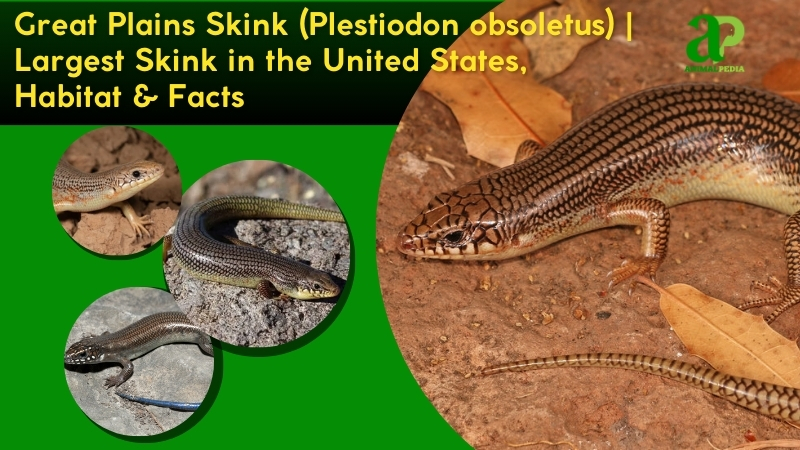
What Is the Great Plains Skink?
The Great Plains skink (Plestiodon obsoletus) is a sizable, terrestrial lizard species that inhabits the open grasslands and rocky territories of North America. Its formal classification places it within the family Scincidae (skinks) and the order Squamata (lizards and snakes), placing it firmly within the reptile class (Reptilia) and the animal kingdom (Animalia) (11, 14). The species was formerly known as Eumeces obsoletus until a taxonomic reorganization in 2005, a detail that remains a point of reference in modern herpetology (13). The scientific name itself provides insight into the animal’s appearance; the specific epithet obsoletus is a Latin term for “faded,” referring to the indistinct mottled pattern that adults display, which is a key physical distinction from other skinks (8). The reptile is also known by other common names, such as the Sonoran skink, which refers to its distribution in the Sonoran Desert (13).
Ongoing research presents competing ideas regarding the species’ biology. Some herpetologists suggest that isolated northern populations, particularly those in Iowa, might merit subspecies designation due to thermal and genetic isolation. Other researchers, however, maintain that a single species designation is appropriate, citing continuity in morphology and genetic makeup (7, 13). Debates also center on the factors that limit the skink’s northern range. Early models suggested temperature constraints, while recent studies highlight the availability of rock shelters as a primary factor (8). The varying scientific perspectives affect conservation strategies, underscoring the dynamic nature of zoological research.
Moving beyond its classification, the skink’s distinctive physical traits are what make it recognizable in its environment. Its unique appearance and anatomical features are key to its survival.
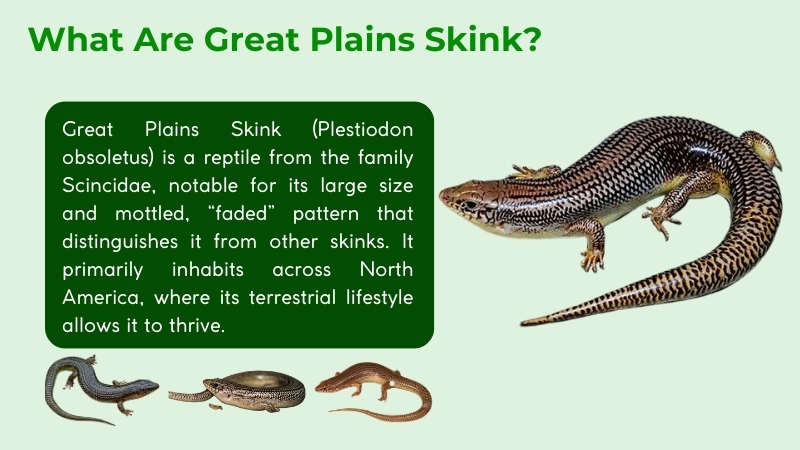
What Does Great Plains Skink Look Like?
The physical appearance of the Great Plains skink is characterized by a robust, cylindrical body adapted for a life spent burrowing and moving through terrestrial environments. Its anatomy includes a thick, muscular torso and neck, with short yet sturdy limbs and a stout tail, which contribute to a low-slung, powerful form. The skin is covered in smooth, glossy scales that serve as a protective barrier and aid in moisture retention in arid climates. The skink’s color palette is light tan to gray, with each dorsal scale edged in black or dark brown, forming an indistinct, mottled pattern along its back and sides (13, 14). This camouflage helps the reptile blend into its natural habitat of rocky grasslands.
This species possesses numerous distinctive features. The Great Plains skink’s most notable physical traits include:
- Conical Head and Strong Jaws: The head is slightly flattened and robust, an ideal shape for pushing through soil or under rocks when burrowing. Its muscular jaws and short snout are designed for crushing hard-shelled prey (11).
- Smooth Scales: The overlapping scales create a shiny, slick texture that reduces friction during movement through underground tunnels. This smooth surface also helps the animal conserve water (13).
- Sturdy Limbs: The four short limbs each have five toes that bear long, curved claws. These claws are a crucial adaptation for digging burrows and climbing over rocks during foraging.
- Pleurodont Teeth: The skink has a number of sharp, pleurodont teeth attached to the inner jawbone. These teeth are specialized for grasping and grinding the exoskeletons of insects and arthropods (11).
- Bright Blue Tail: Juvenile Great Plains skinks are easily identified by a brilliant blue tail that contrasts sharply with their solid black bodies. This vibrant coloration functions as a visual lure, drawing a predator’s focus away from the more vulnerable parts of the skink’s body (11, 13).
Sexual dimorphism is evident in the species’ appearance. During the breeding season in the spring, adult males develop bright orange or red patches on their heads, necks, and forelimbs, a display of color absent in females. The males also tend to be larger and heavier than their female counterparts.
The skink’s size is another important physical characteristic that sets it apart from other species. Its considerable dimensions make it a notable presence in the reptile world.

How Big is the Great Plains Skink?
The Great Plains skink is considered the largest skink in the United States, with adult individuals averaging 8-9 inches (20-23 cm) in total length and weighing 0.7-1.1 ounces (20-30 g) (13, 14). The largest recorded individual measured an impressive 13.7 inches (34.9 cm) in length and weighed 1.4 ounces (40 g) (11, 13). Growth and development occur in distinct stages. Hatchlings emerge from their eggs at a length of approximately 1.2-1.6 inches (3-4 cm) and grow rapidly during their first year. They reach near-adult size as juveniles within a year, achieving reproductive maturity between one and three years of age (11).
Males are typically larger than females, a form of sexual dimorphism that helps differentiate the sexes. For a sense of scale, a typical adult skink is about the length of a common ballpoint pen. This species’ size and robust build are key features that define it within its habitat.
| Male | Female | |
| Length | Up to 5.5 inches (14 cm) SVL | Up to 4.7 inches (12 cm) SVL |
| Weight | Heavier, up to 1.4 ounces (40 g) | Lighter, up to 1.1 ounces (30 g) |
| Record Size | 13.7 inches (34.9 cm) total length | Not specified |
The skink’s size is directly related to where it lives. Understanding its habitat is essential to appreciating how this animal survives and thrives.
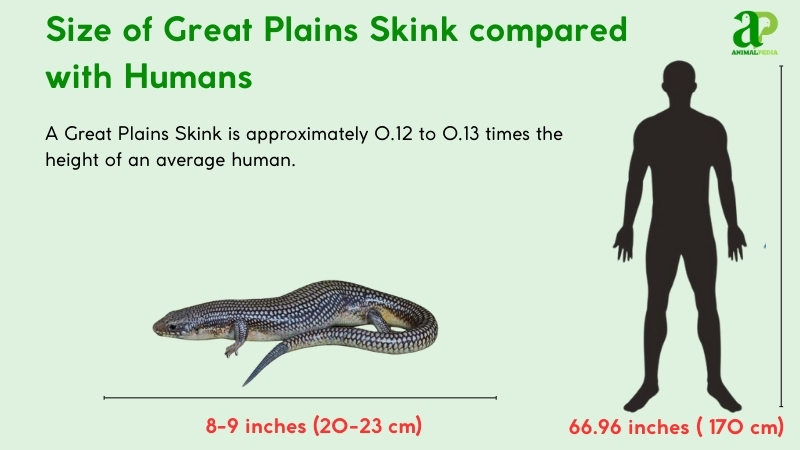
Where Does Great Plains Skink Live?
The Great Plains skink is widely distributed across the central United States and Mexico, thriving in specific terrestrial environments that provide essential cover and thermal regulation (8, 13). Its native range spans the central Great Plains, from southeastern Wyoming through Nebraska, Kansas, Oklahoma, and eastern Colorado, extending south into central and eastern Mexico (7, 13). This lizard’s preference for arid and semi-arid habitats is consistent across its extensive distribution, with populations found in open grasslands, prairies, and woodlands with ample rock or log cover (6, 13). The availability of these rocky shelters is a primary determinant of where the skink resides, a factor that influences its presence more than climate alone (8).
The species’ adaptability allows it to inhabit a considerable elevation range, reaching up to 6,500 feet (2,000 meters) above sea level (8). To cope with the significant temperature fluctuations in these environments, the skink relies heavily on its fossorial, or burrowing, behavior, creating underground refuges that maintain a stable temperature. While individuals are largely solitary, they occupy distinct home ranges with access to necessary resources. This consistent presence in specific areas highlights the species’ reliance on stable microhabitats within its broad distribution.
Its habitat shapes its day-to-day existence, including how it behaves to find food and avoid danger. Observing the skink’s behavioral patterns reveals how it adapts to its challenging environment.
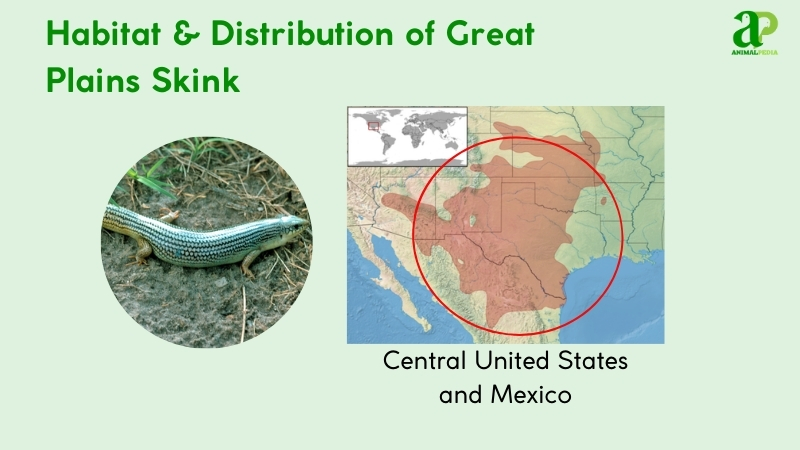
How Does Great Plains Skink Behave?
The Great Plains skink displays a range of behaviors that facilitate its survival within its native habitat. Its behavioral repertoire is centered on foraging, avoiding predators, and regulating body temperature. These core behaviors are shaped by the skink’s environment and its need to find sustenance.
- Diet and Feeding: This opportunistic carnivore uses its powerful jaws to crush insects and arthropods, its primary food sources.
- Movement and Abilities: The skink is a fast, terrestrial runner that uses serpentine movements and powerful claws for burrowing.
- Daily/Seasonal Patterns: It is a diurnal reptile, active during the day, and it enters brumation during the colder winter months.
Diet and Feeding
The Great Plains skink is an opportunistic carnivore, primarily eating arthropods (3, 12). Its diet consists mainly of grasshoppers, crickets, beetles, and spiders. It also consumes small lizards, newborn rodents, and the eggs of other reptiles when the opportunity arises (3, 12). The skink actively forages, using its keen sense of smell, or chemoreception, to locate prey. When a target is found, it strikes with a quick, snapping bite. The powerful jaws and specialized pleurodont teeth are adapted for crushing the hard exoskeletons of insects. This species hunts on the surface and within its burrows.
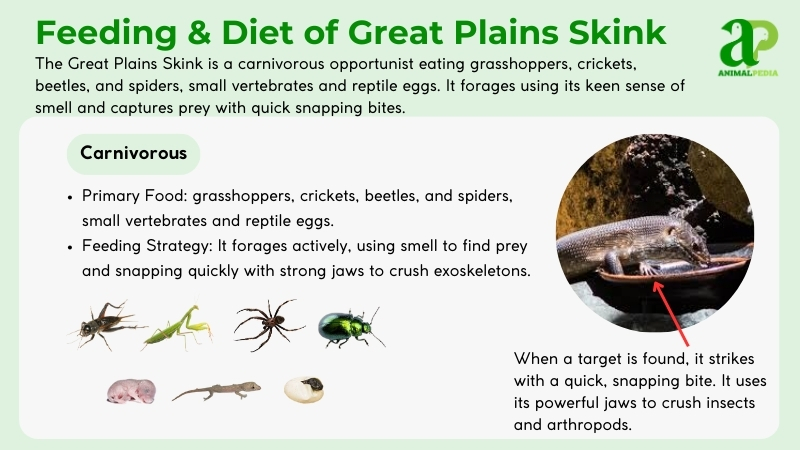
Movement and Abilities
The Great Plains skink moves with a serpentine, lizard-like gait, often a combination of running and walking. This species is capable of quick, agile sprints across open ground, and it is an adept burrower, using its sturdy limbs and claws to dig through soil and debris. While no widely documented data for this species’ top speed exists, related skinks are capable of reaching high speeds. The species’ most notable defensive ability is tail autotomy, where the skink voluntarily detaches its tail to escape from predators (2, 13). The bright blue tail of a juvenile is believed to enhance this behavior by drawing the predator’s attention away from the body (11, 13).

Daily/Seasonal Patterns
The Great Plains skink is a diurnal reptile, meaning it is most active during daylight hours, primarily for foraging and thermoregulation. Its activity is highly seasonal, peaking in spring and early summer when mating and food sources are abundant (10, 12). As temperatures drop in late autumn, the skink enters a state of brumation, a period of inactivity where metabolic processes slow down. During this time, it seeks refuge deep underground or in rock crevices to survive the winter (10). While they do not undertake long-distance migrations, these skinks may move between burrows or home ranges to find new food sources or mates.
The ability to reproduce and create new generations is fundamental to the survival of the species. The skink’s unique reproductive habits and parental care are noteworthy.
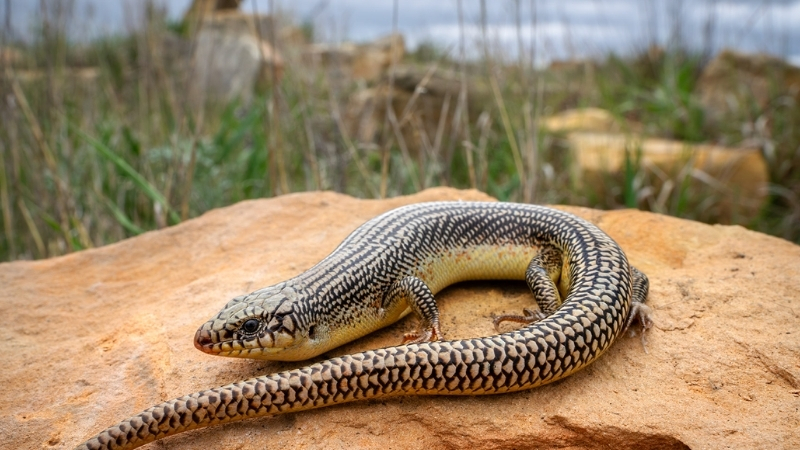
How Does Great Plains Skink Reproduce?
The Great Plains skink is an oviparous species, meaning it reproduces by laying eggs, a common trait among many reptiles. Its mating season takes place during the spring, typically from late April to May, after the skinks emerge from brumation (4, 10). During this time, males exhibit courtship rituals involving territorial displays and aggressive encounters to secure mates. The female lays a clutch of between 10 and 20 eggs in a shallow burrow or a nest beneath a rock or log in early summer. A unique behavior, known as maternal care, is a notable aspect of this species’ reproduction (4, 10). Females remain with their eggs, guarding the nest from predators and occasionally rotating the eggs to ensure consistent temperature and moisture levels. This protective care continues until the hatchlings emerge approximately one to two months later.
This dedicated parental care is essential for the skink’s lifespan. By examining its longevity, we can better understand the species’ life cycle and ability to sustain its population.
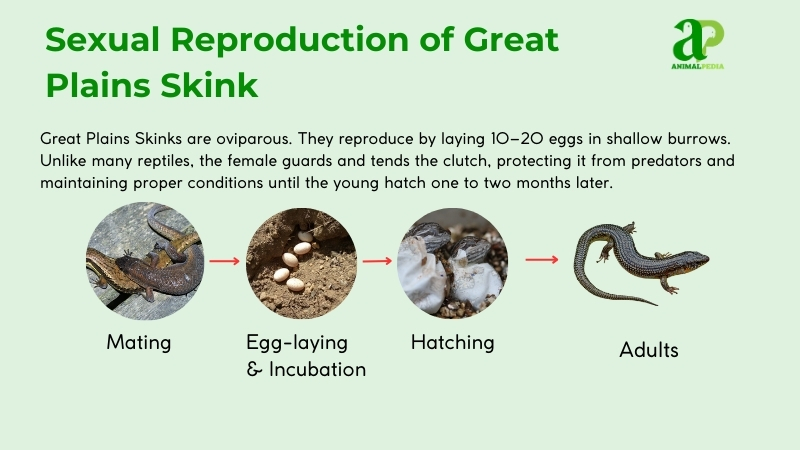
How Long Does Great Plains Skink Live?
The Great Plains skink lives for approximately 5 to 10 years in the wild. Its longevity is influenced by multiple environmental factors, including predation, disease, and the availability of food sources. In captivity, a skink can live for over 10 years, a longer lifespan attributed to consistent food, shelter, and freedom from predators and environmental pressures (5). The species achieves reproductive maturity between one and three years of age, a phase that marks the transition from juvenile to adult life.
Beyond its own life cycle, this skink provides several benefits to the environment and, by extension, to humans. Its ecological role highlights its value as a natural pest controller.
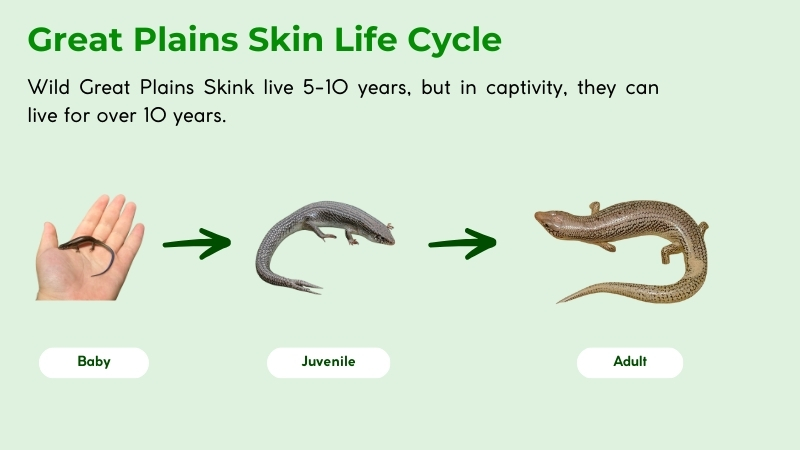
Is Great Plains Skink Beneficial to Humans?
The Great Plains skink is beneficial to humans, primarily due to its role as a natural predator of many arthropods. This reptile’s diet includes numerous insects and arachnids considered agricultural pests, such as grasshoppers, beetles, and spiders (3). By preying on these organisms, the skink contributes to the control of pest populations, which helps protect crops and maintain ecosystem balance (12).
The skink’s presence indicates a healthy local ecosystem. It acts as a bioindicator for environmental quality. The species is not considered a pest and does not harm human infrastructure. There is no significant cultural or economic use of this species by humans; its value is purely ecological, as its diet helps to naturally regulate local insect populations (3).
Given its widespread presence, it is natural to wonder about its conservation status. Its current population health is an important indicator of the ecosystem’s stability.
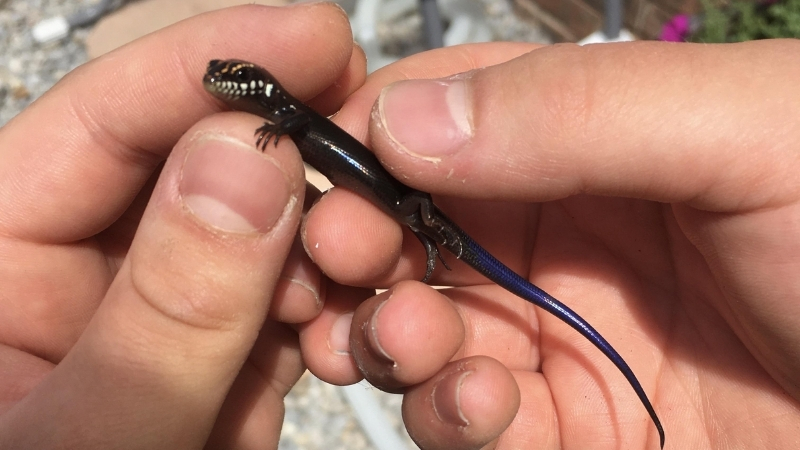
Is the Great Plains Skink Endangered?
The Great Plains skink is not considered endangered; it is classified as Least Concern on the IUCN Red List of Threatened Species, indicating a stable and widespread population (12, 14). While the species is not at risk of extinction, specific regional populations face threats. The primary risks are habitat fragmentation caused by urban development and large-scale agriculture (7).
Humans can aid in the species’ survival. The skink is often mistaken for a snake and killed, but it is a harmless, non-venomous lizard (13). Conservation efforts focus on preserving its native grassland and prairie habitats and promoting awareness of its benign nature. By avoiding harm to these animals and protecting their environments, people directly contribute to the long-term health of their populations (7).
Beyond its classification, this skink possesses several surprising and interesting characteristics. Many fascinating facts about its behavior and biology showcase the animal’s unique nature.
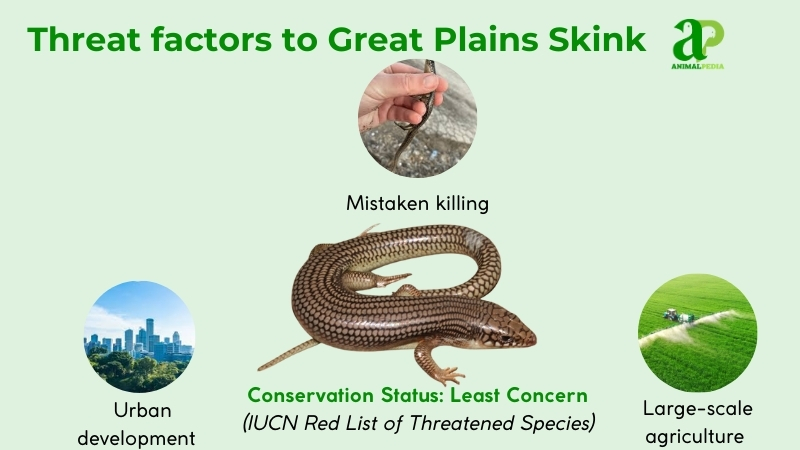
Frequently Asked Questions About Great Plains Skink
Are Great Plains Skinks Poisonous?
No, Great Plains skinks are not poisonous and pose no threat to humans or pets (13). This species is non-venomous and has a docile temperament. Its sole defense mechanism is to bite when handled or to detach its tail to escape from a predator.
How Does The Great Plains Skink Defend Itself?
The skink’s primary defense is to escape from predators by either burrowing into the ground or detaching its tail in a process called autotomy (2, 13). The wriggling, detached tail distracts predators while the lizard flees to safety.
Can the Great Plains Skink be kept as a pet?
While some people keep them as pets, it is not recommended for a variety of reasons (13). The species requires a specialized environment with specific temperature and humidity levels and live insects for food, making it a challenging reptile to care for properly.
When and how do Great Plains Skinks hibernate?
Great Plains skinks enter a state of brumation, a form of inactivity in reptiles, during the colder months (10, 12). They seek shelter in deep burrows or crevices to avoid freezing temperatures and slow their metabolism to survive on stored energy.
How does the Great Plains Skink differ from other skink species?
The Great Plains skink is differentiated from other skink species by its larger size, reaching up to 13.7 inches (34.9 cm) in length, and the faded, mottled pattern on its body as an adult (11, 13). Other species often have distinct stripes or uniform coloration throughout their lives.
Conclusion
The Great Plains skink is a fascinating example of adaptation and resilience within the reptile world. From its impressive size and unique physical appearance to its complex behaviors like maternal care and thermal regulation, this species demonstrates a specialized ability to thrive in its environment. Its presence is not only an indicator of a healthy ecosystem but also a direct benefit to humans through natural pest control. At Animal Pedia, we are dedicated to providing scientifically accurate information through engaging, educational content. Explore our vast encyclopedia to discover more about the incredible diversity of life on Earth and gain a deeper understanding of the animal kingdom.




